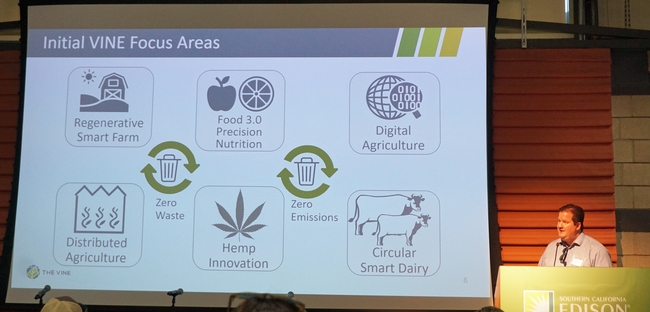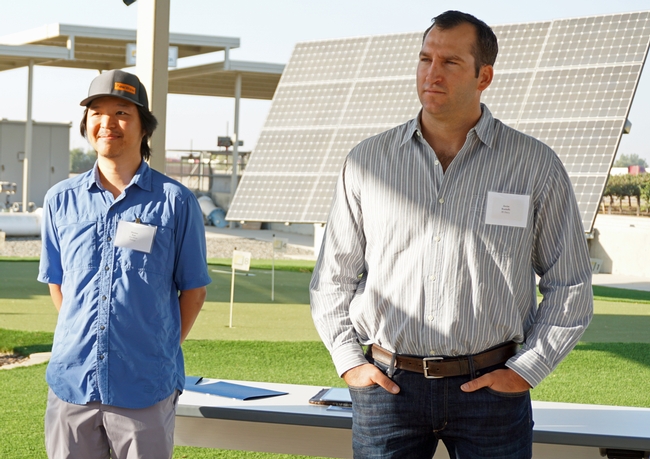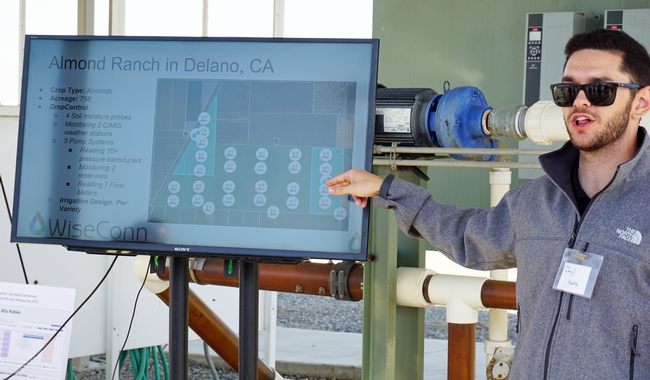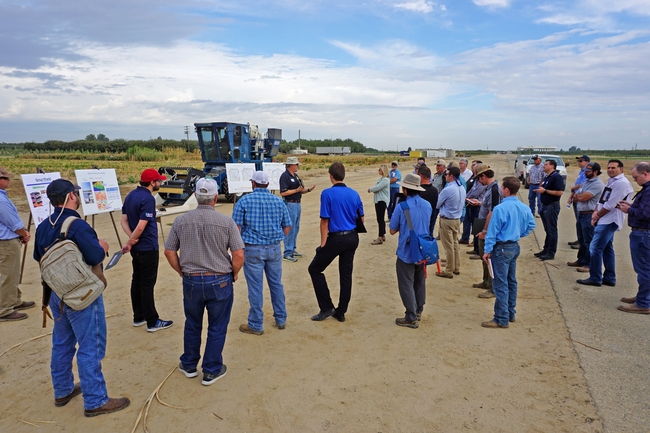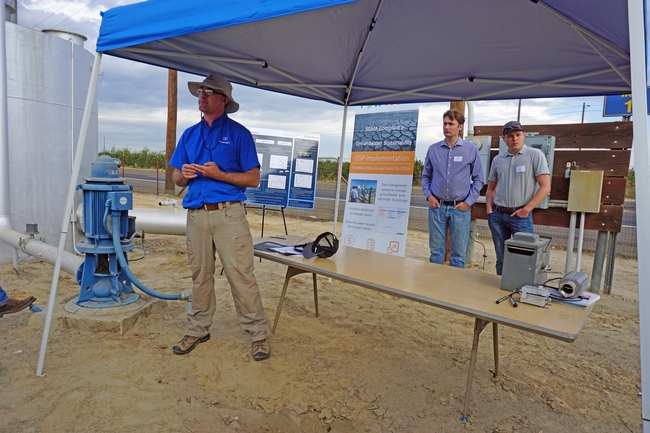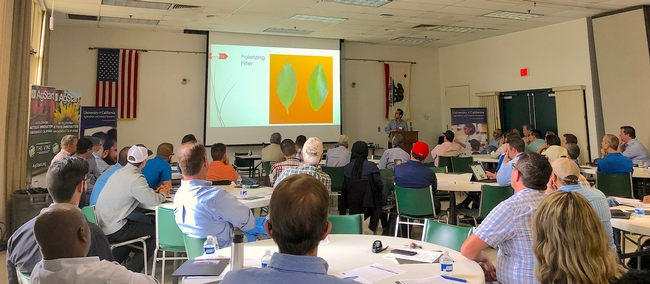Posts Tagged: technology
Christian Nansen: Researchers Must Embrace and Integrate Technology
Technology matters. It's not enough for entomologists to do research; they must also embrace and integrate technology, says agricultural...
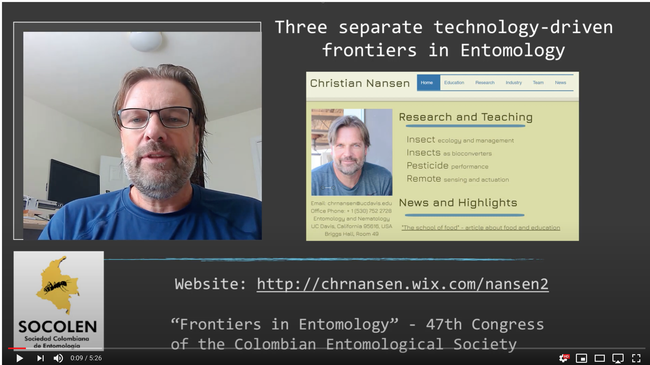
UC Davis agricultural entomologist Christian Nansen delivering his keynote presentation to the 47th Congress of the Colombian Entomology Society.
Farming technology focus at Open Farm 2019
From robot vacuum cleaners and doorbell cameras to social media and e-commerce, technology is continually transforming lives and businesses. The world's oldest industry – agriculture – is no exception.
Remote sensors are all but eliminating the need for farmers to walk plant rows and make decisions based solely on observations, experience and intuition. New technologies that gather and analyze data can optimize crop needs, reduce environmental impacts, increase efficiency, cut energy costs and save water. The latest innovations were on display at the fourth annual Open Farm conference Oct. 23 in Tulare.
A demonstration by PowWow Energy showed artificial intelligence technology not only improving farming, but also spinning off new ideas and local businesses in rural communities. PowWow supports farms who have solar panels with information to optimize their return on investment. By monitoring weather, utility rates and meters, and the panels' energy generation, the company calculates precisely when energy losses caused by dust on the solar panels are valued higher than the cost of cleaning them. When it's time to wash the panels, farmers receive a text notification.
That got Tulare County dairy farmer Justin Roeloffs thinking about the growing need to efficiently clean dust from solar panels. He built a solar panel cleaning system that was so effective, he started a business – Roeloffs Solutions – to offer panel cleaning to other solar owners, creating new jobs in the farming community.
“The almond season is a disaster for solar panels,” Roeloffs said. “Some farmers buy a kit and do it themselves, but we had many calls for our service the first month in business.” Last summer, Roeloffs Solutions cleaned panels that generate 30 megawatts of power.
The founder of Concentric Power, Brian Curtis, explained the business he built to manage the energy usage and needs of large food processors, beginning in the Salinas Valley. The system allows businesses to save money on their energy bills, maximize the use of renewable energy and maintain reliable energy availability, even during blackouts and brownouts. Concentric Power combines wind, solar, co-generation and battery storage to develop a company's own micro-grid.
“The recent public safety power shutoffs are ringing our bell,” Curtis said. “The stars have aligned for us.” So far three Salinas Valley food processors and one in Bakersfield have installed the micro-grid systems. Curtis said energy intensive ag industries – such as dairies, cheese processors and wine producers – are potential clients.
A variety of other automation solutions were also shared at Open Farm:
- Darryl Hadlich of WiseConn said the company's precision irrigation timing system – monitored by infield sensors and controlled by in-field nodes – allows farmers to schedule, start and end irrigation and fertigation using their cellphones or desktop computers. The associated software also shows when energy companies offer lower, off-peak rates to enable irrigation scheduling when the cost to operate the pump will be at its lowest.
- Conner Kingman of Kingman Ag Service is perfecting technology to reconfigure the tractors farmers already own with artificial intelligence-aided computers to pull a wide variety of farm implements through the field, such as a spring tooth cultivator, mower, shredder and sprayer. The driverless tractors reduce labor needs, and enable farm work to continue around the clock without breaks or worker safety concerns.
- Jose Baer at PowWow Energy detailed programmable irrigation systems for small and large farming operations. The field is monitored with aerial images and uses data from in-field sensors for targeted water application.
- John Cardoza of Sustainable Conservation explained a collaborative research project that studied methods for dairy wastewater management using sensors, sand media filters and drip irrigation. In the study, nitrous oxide emissions were cut by 70%, water use by 36% and nitrogen applications by 45%.
During a researcher and industry panel on the state of technology integration from the grower's perspective, participants reflected on how technology will help prepare for the future. The panel was moderated by Dennis Donahue, director of Western Growers Center for Innovation and Technology:
- Director of the Tulare County Resource Conservation District Mike Chrisman, a long-time Tulare County farmer, noted that data will be increasingly critical for farming as California agriculture enters the Sustainable Groundwater Management Act era in 2020. The law requires that California groundwater usage be “sustainable” by 2040 – meaning that the amount that is drawn out must match the amount that is recharged. “This will change the way we all do business,” Chrisman said. “Agriculture in 20 years won't look like it looks today.”
- Jeff Dahlberg, director of the UC Kearney Agricultural Research and Extension Center and a sorghum extension specialist, said high technology companies will rely on UC researchers to confirm that their products are meeting expectations. UC scientists can contribute by applying their knowledge on plant growth and development. “We understand biology and how plants use water,” he said. “We will be asked to ground truth technology.”
The event is a collaborative effort by UC Agriculture and Natural Resources, Fresno State's BlueTech Valley, the California Energy Commission, PowWow Energy, West Hills College and the Western Grower Center for Innovation and Technology. Open Farm 2019 was hosted at the Southern California Edison Energy Education Center.
Agtech is changing farming in California
Technology holds tremendous promise for the California agricultural industry, however there are challenges that must be better understood and managed, wrote Damon Kitney in an article distributed to participants in an Oct. 2 technology conference in San Francisco.
Using artificial intelligence to speed up genetic selection is one area where technology is evolving in the laboratories of the Silicon Valley. Glenda Humiston, the vice president for UC Agriculture and Natural Resources, was quoted extensively in Kitney's article about the potential of AI and other technologies in agriculture.
"Artificial intelligence is extremely difficult in agriculture because of the huge amount of variability in environmental conditions across a single field," Humiston said. "This requires many sensors, complex algorithms and large real-time data processing - all integrated and working together to inform decisions and actions."
Humiston said the ability to pull together an array of data - from drones, robots, sensors and genomics - and use it for informed decision making will require significant improvements in how 'big data' is managed. Point solutions are being developed by universities, startups and corporate innovators, but few are integrated to provide real-life solutions for farmers.
"Integration will be a key factor in making these technologies affordable and available to most farmers," she said. "Many startup technologies for agtech are hitting the market with glossy websites, pitch events and marketing materials that appeal to investors, but the science behind them is dubious."
A key issue covered in the article is the cost and availability of labor in berry production. About 60 percent of the costs associated with berries are labor. At times, a significant portion of berries are lost when farmers can't find labor to get them picked.
Despite the effort to find technology to cut labor needs, human labor in the field will never be replaced, according to Mark Bolda, UC Cooperative Extension strawberry and caneberry advisor for Santa Cruz County.
"It's not realistic to see robots as the full solution for our labor issues, rather more success will be found in berries by combining robots with already existing labor of humans," he said.
Berries are very soft fruits. Technology to find them, pick them and put them in a box does not exist, Bolda said. Robots of the future will likely transport full boxes out of the field, bring in new boxes, monitor the rate of picking and charting field issues.
UCCE farm management advisor Laura Torte concurs.
"Humans bring sensory attributes to agriculture that robotics and mechanization has not - yet - been able to perfect," she said.
Open Farm 2018 and UC ANR promote ag technology
A torrent of technology is flowing into the agricultural sector. To make sense of it, UC Agriculture and Natural Resources, Fresno State and West Hills Community College came together with technology vendors and growers at Open Farm 2018, held in October at UC ANR's Kearney Agricultural Research and Extension Center in Parlier.
“A lot of technology is coming out,” said Kearney director and UC Cooperative Extension agronomy specialist Jeff Dahlberg. “I need to caution you, it's not all is based on science. We are helping with testing.”
Dalhberg has been working with Blue River Technologies to monitor the growth of dozens of sorghum cultivars. Throughout the growing season, Blue River flew drones over the sorghum nursery with cameras to capture their growth and development.
“We have a huge phenotypic dataset,” Dalhberg said. “It will be compared at the genetic level with plant samples and help us identify genes associated with drought tolerance.”
At Open Farm, Dahlberg's field presentation was paired with Smartfield, a company that uses fixed cameras and field sensors to gather information for “big data crunching.”
PowWow Energy, based in San Francisco with a field office at the Water, Energy and Technology (WET) Center at Fresno State, met near a well at Kearney to explain how the company can help growers with decision support tools. The company believes their technology will be useful for farmers tracking groundwater usage, data that will be key to complying with new rules associated with the Sustainable Groundwater Management Act (SGMA). SGMA, signed by Gov. Brown in 2014, gives local agencies the authority to manage groundwater in a way that achieves sustainability by 2042.
UCCE agriculture mechanization specialist Ali Pourezza introduced a prototype he developed with junior specialist German Zuniga-Ramirez that he believes will make early detection of the devastating citrus disease huanglongbing as easy as taking a photo with a smartphone camera.
The idea is based on the optical characteristics of the disease in leaves. By using a polarizing light, leaves on diseased trees are immediately identified. Infected trees can then be torn out before insects have the chance to spread the disease to other trees.
Pourezza and Zuniga-Ramirez are seeking funding to take the prototype to the next level, and eventually commercialize the product.
This sampling of innovations being showcased at Kearney is part of a continuing effort by UC to connect the ag community with technology developers and resources that is shepherded by a new UC ANR program called The VINE, Verde Innovation Network For Entrepreneurship. The VINE was created by UC ANR in 2017 to link entrepreneurs with mentors, advisors, collaborators, events, competitions and education.
At Open Farm 2018, UC ANR vice president Glenda Humiston was the keynote speaker. She outlined three areas where farmers, the technology sector and academia can work together to accelerate technology application in rural parts of California: improve broadband access, identify high-value uses for biomass and establish water infrastructure in rural communities.
To address the broadband issue, Humiston is leading an initiative to document mobile internet speed across California – including rural areas. In April 2019, Humiston plans to enlist 4-H members across the state to test internet speed using the free smartphone app CalSpeed several times over a period of a week.
“This will give us a snapshot of mobile broadband service availability,” Humiston said.
The crisis in the Sierra Nevada – where millions of trees died from the drought of 2010-16 – could prompt the development of high-value uses of biomass and establish a market for biomass derived in the agricultural sector, she said.
Humiston also took the opportunity to ask participants to help make sure the critical services UC ANR provides – including county-based UC Cooperative Extension, nine research and extension centers, the UC integrated pest management program, 4-H youth development, UC Master Gardeners and others – continue to fuel the California economy. Diminished funding from the State of California is taking a toll on the UC ANR budget.
“We need people like you to work with the VINE to set up improved support,” Humiston said.
And the (Bee) Beat Goes On...
It was bound to happen. A "real" honey bee flying alongside "fake" bees on a bee crossing sign. We photographed this honey bee (below) at 1/1000 of...
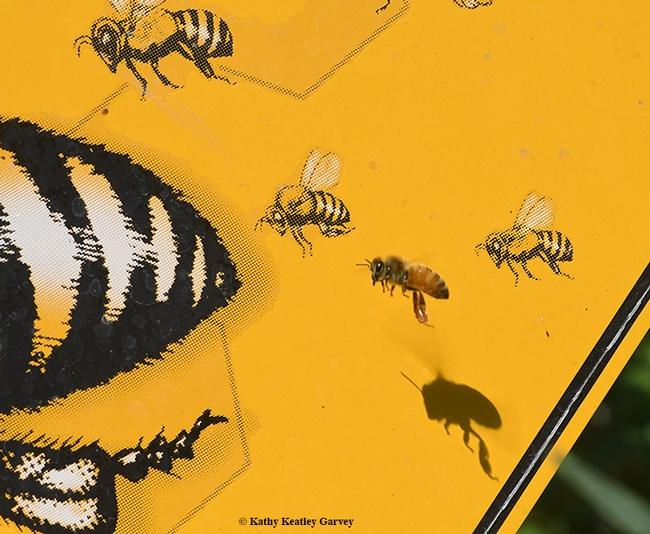
A honey bee flies in formation with "fake" bees on a bee crossing sign. Bees can flap their wings around 240 times per second. (Photo by Kathy Keatley Garvey)
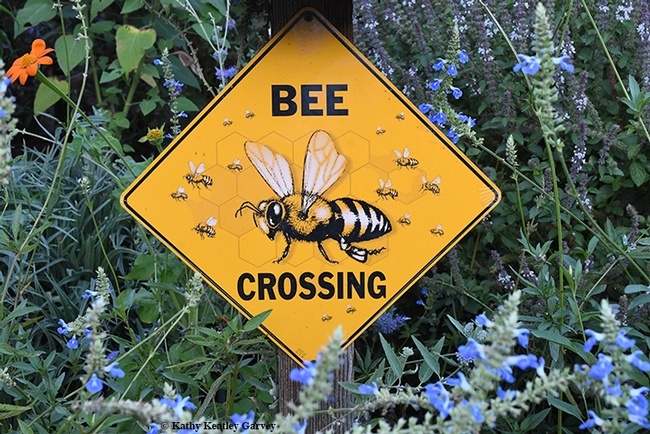
It's almost flyover time again. Blue spike sage (Salvia uliginosa) is in the foreground. (Photo by Kathy Keatley Garvey)


